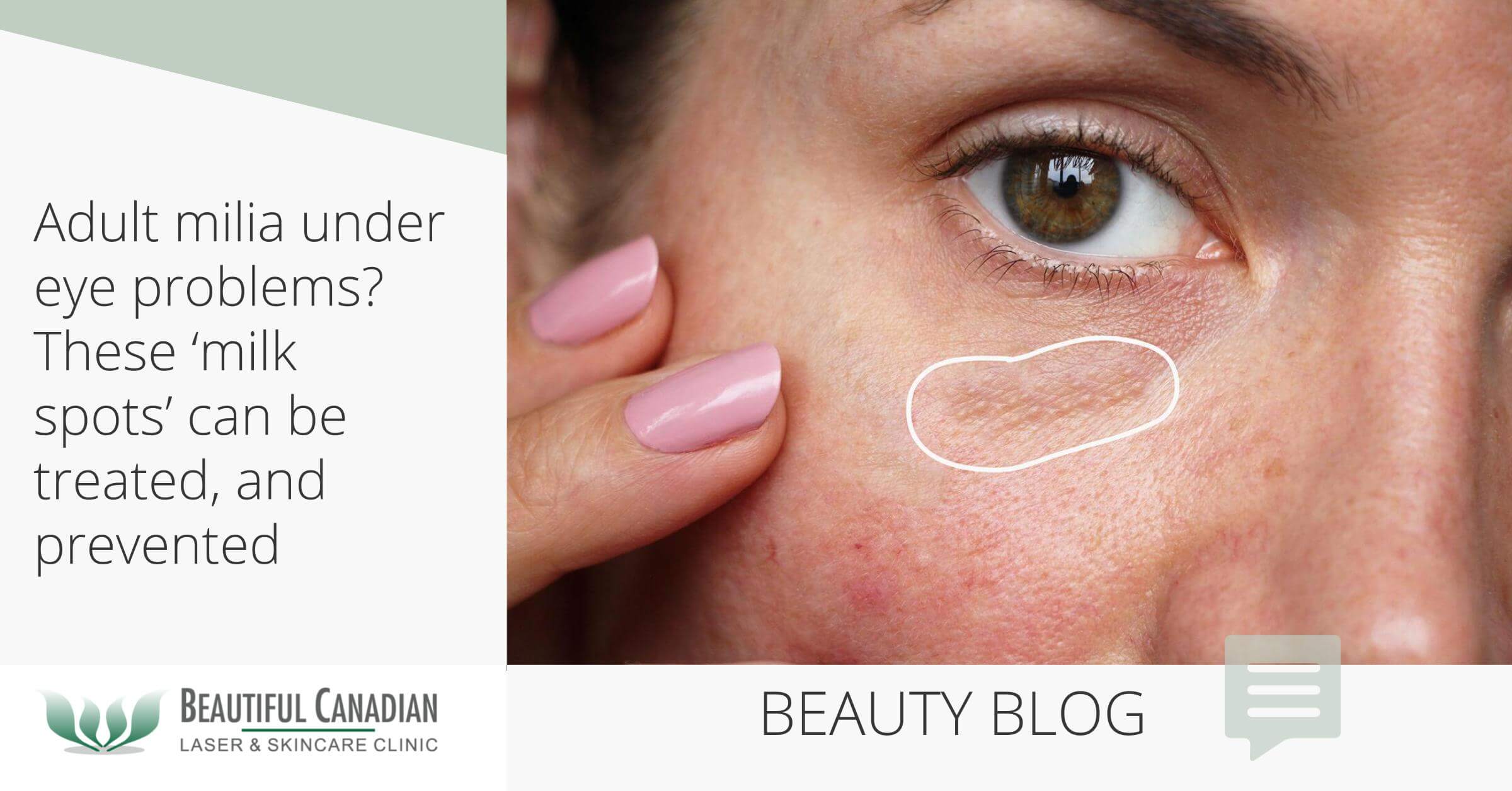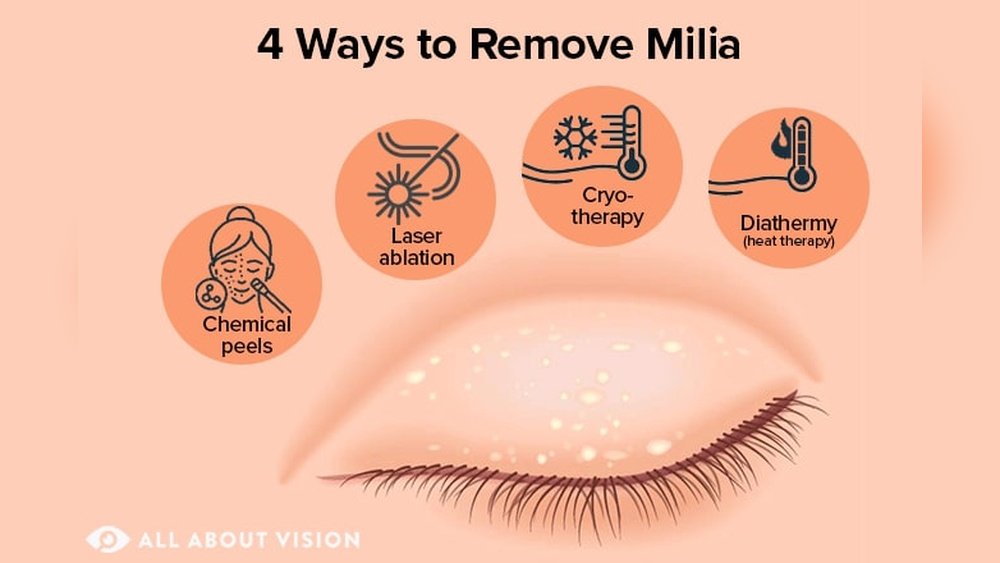Are you noticing tiny white bumps around your eyes that just won’t go away? Those little spots are called milia, and while they’re harmless, they can be frustrating and affect your confidence.
You might be wondering how to safely get rid of them without causing damage to the delicate skin near your eyes. The good news is, there are effective ways to treat small milia that you can either try at home or with the help of a skincare professional.
You’ll discover practical tips and trusted treatments that will help you clear those stubborn bumps gently and prevent them from coming back. Keep reading to learn exactly what you should do—and what to avoid—to get smooth, clear skin around your eyes.

Credit: www.bclaserandskincare.com
Professional Removal Techniques
Professional removal techniques offer safe and effective options to treat small milia around the eyes. These treatments are performed by dermatologists or trained skincare professionals. They ensure minimal discomfort and reduce the risk of scarring. Choosing the right method depends on the size and number of milia and skin sensitivity.
Manual Extraction
Manual extraction involves a dermatologist making a tiny incision over each milia. The contents are gently removed using a small tool. This procedure is quick and causes little pain. It is one of the most common methods to clear milia near the eyes.
Cryotherapy
Cryotherapy uses liquid nitrogen to freeze milia. The frozen skin then sheds, removing the bumps. This technique targets the milia without harming nearby skin. It works well for stubborn or multiple milia.
Laser Resurfacing
Laser resurfacing sends focused light beams to break down milia under the skin. It also stimulates skin healing and collagen production. This method can improve skin texture and reduce milia recurrence. It suits people with sensitive or delicate skin.
Electrodesiccation
Electrodesiccation applies an electric current to dry out milia. The treated area forms a scab that falls off naturally. This method controls bleeding and prevents infection. It is precise and effective for removing small milia.
Chemical Peels
Chemical peels use a solution to remove the outer skin layer. This helps clear milia and renew skin cells. Peels vary in strength and type to suit different skin needs. They also improve overall skin tone and smoothness.
Daily Skincare Tips
Daily care plays a key role in treating small milia around the eyes. A consistent skincare routine helps keep the skin clean and healthy. It also prevents new milia from forming. Simple steps can improve the skin’s texture and reduce milia gently.
Gentle Cleansing Routine
Use a mild cleanser made for sensitive skin. Wash your face twice a day to remove dirt and oil. Avoid harsh soaps that dry out the skin. Pat the skin dry with a soft towel instead of rubbing. This keeps the delicate eye area calm and protected.
Proper Exfoliation
Exfoliate the skin around the eyes gently two times a week. Use a soft exfoliant with small, smooth particles. Avoid rough scrubs that can irritate or damage the skin. Warm compresses before exfoliating help soften milia. This makes it easier to clear dead skin cells safely.
Using Sunscreen
Apply a broad-spectrum sunscreen every day, even on cloudy days. Choose a formula safe for the eye area that does not sting or cause redness. Sunscreen protects the skin from sun damage, which can worsen milia. Regular use helps keep skin smooth and healthy.
Topical Treatments
Topical treatments offer a convenient way to manage small milia around the eyes. These treatments work by promoting gentle exfoliation and preventing the buildup of dead skin cells. Consistent use can reduce milia and improve skin texture over time. It is important to choose products suitable for sensitive skin near the eyes to avoid irritation.
Retinoid Creams
Retinoid creams help speed up skin cell turnover. They prevent keratin from clogging pores, which causes milia. These creams can soften and shrink milia with regular use. Prescription options like tretinoin are strong but effective. Over-the-counter retinoids are milder and good for beginners. Apply a small amount at night and avoid direct contact with eyes. Start slowly to reduce irritation and dryness.
Over-the-counter Options
Many gentle products can help treat milia without a prescription. Look for creams or serums containing alpha hydroxy acids (AHAs) or beta hydroxy acids (BHAs). These acids exfoliate the skin and clear pores. Products with ingredients like glycolic acid or salicylic acid work well. Use a pea-sized amount on clean skin around the eyes. Avoid harsh scrubs or strong chemicals to protect delicate skin. Consistent use helps prevent new milia from forming.

Credit: aventusclinic.com
Preventing Milia Formation
Preventing milia formation around the eyes helps keep the skin smooth and clear. Taking gentle care reduces the chance of small white bumps appearing. Proper habits and products protect the delicate skin and stop milia from forming.
Avoiding Skin Irritation
Skin irritation can trigger milia near the eyes. Use mild cleansers that do not dry or sting the skin. Avoid scrubbing the area hard during washing. Do not use strong exfoliants or harsh chemicals close to the eyes.
Keep skincare simple and gentle. Avoid heavy creams that clog pores. Choose non-comedogenic products labeled safe for sensitive skin. Stop using any product that causes redness or itching immediately.
Protecting Delicate Eye Skin
The skin around the eyes is thin and fragile. Use sunscreen daily to protect against sun damage. Wear sunglasses to shield the skin from UV rays and wind. Avoid rubbing or touching the eye area frequently.
Apply eye creams softly with your ring finger. This finger applies the least pressure and reduces risk of irritation. Keep makeup light and remove it carefully each night. Proper protection helps prevent milia and keeps skin healthy.
Risks Of Home Remedies
Many people try home remedies to remove small milia around the eyes. These remedies may seem simple and cheap. Yet, they carry risks that can harm your delicate skin. Understanding these risks helps you make safer choices for treating milia.
Potential Skin Damage
Home remedies often involve harsh ingredients. These can irritate the thin skin near your eyes. Irritation may cause redness, swelling, or even burns. Using strong acids or scrubs can break the skin’s barrier. This damage increases the chance of infection and scarring. The eye area is sensitive, so gentle care is essential. Avoiding aggressive treatments protects your skin’s health.
Ineffective Treatments To Avoid
Some common home remedies do not clear milia effectively. Remedies like toothpaste, baking soda, or lemon juice have no scientific support. These treatments can dry out the skin or disrupt its natural balance. They often leave milia unchanged or worse. Wasting time with these methods delays proper care. It is better to follow proven treatments recommended by skincare professionals.

Credit: www.icliniq.com
When To See A Dermatologist
Knowing when to see a dermatologist for milia around your eyes is important. Small milia often clear up on their own or with simple care. Some cases need expert attention to avoid complications. Early professional help can protect your skin and improve results.
Signs Milia Needs Professional Care
Milia that persist for weeks or months may need a doctor’s care. Pain, redness, or swelling around the milia signals infection or irritation. If milia multiply quickly or form large clusters, see a dermatologist. Milia that affect your vision or cause discomfort require medical advice. Avoid squeezing or picking as this can worsen the condition.
Benefits Of Expert Treatment
A dermatologist safely removes milia with precise tools and techniques. Professional extraction reduces the risk of scarring and infection. Treatments like cryotherapy or laser resurfacing offer effective, quick results. Experts can prescribe topical retinoids to prevent new milia from forming. A dermatologist also guides you on proper skincare to maintain healthy skin.
Frequently Asked Questions
How To Get Rid Of Milia Near The Eye?
Consult a dermatologist for professional extraction or treatments like cryotherapy and laser resurfacing. Use gentle cleansing, exfoliate softly, apply topical retinoids, and avoid picking or harsh products near the eye. Always protect skin with sunscreen to prevent milia recurrence.
How To Treat Milia In Toddlers?
Treat milia in toddlers by gently cleansing their skin daily with mild soap. Avoid picking or squeezing. Consult a pediatric dermatologist for safe removal if needed. Maintain a gentle skincare routine and keep the area moisturized to prevent recurrence.
Can I Get Rid Of Milia Naturally?
Yes, you can reduce milia naturally by gently cleansing, exfoliating, and using topical retinoids. Avoid picking or harsh products to prevent scarring.
What Is The Main Cause Of Milia?
Milia mainly form due to trapped dead skin cells beneath the skin’s surface, creating small cysts.
Conclusion
Treating small milia around the eyes requires patience and care. Always cleanse gently and avoid harsh products. Professional removal by a dermatologist is often the safest option. Do not squeeze or pick at the bumps to prevent scarring. Regular exfoliation and using recommended creams can help reduce milia over time.
Protect your skin with sunscreen daily to avoid damage. A simple, consistent skincare routine supports healthy skin and helps prevent new milia from forming. Taking these steps can keep the eye area clear and smooth.
 Skip to content
Skip to content 